January 30th, 2017
BURLINGTON, ON
Back in October of last year Ward 2 Councillor Marianne Meed Ward told her following, that the city was “poised to endorse “interim” tall building guidelines and then send them out for public consultation. “You need to make your voice heard, because Burlington’s future will be shaped by these guidelines. I didn’t endorse the guidelines at committee and won’t at council.”
“The guidelines are more than an endorsement of good design. They’re an endorsement of tall buildings. They could lead to approvals for tall buildings on lots not intended for them, so long as they conform to the guidelines.
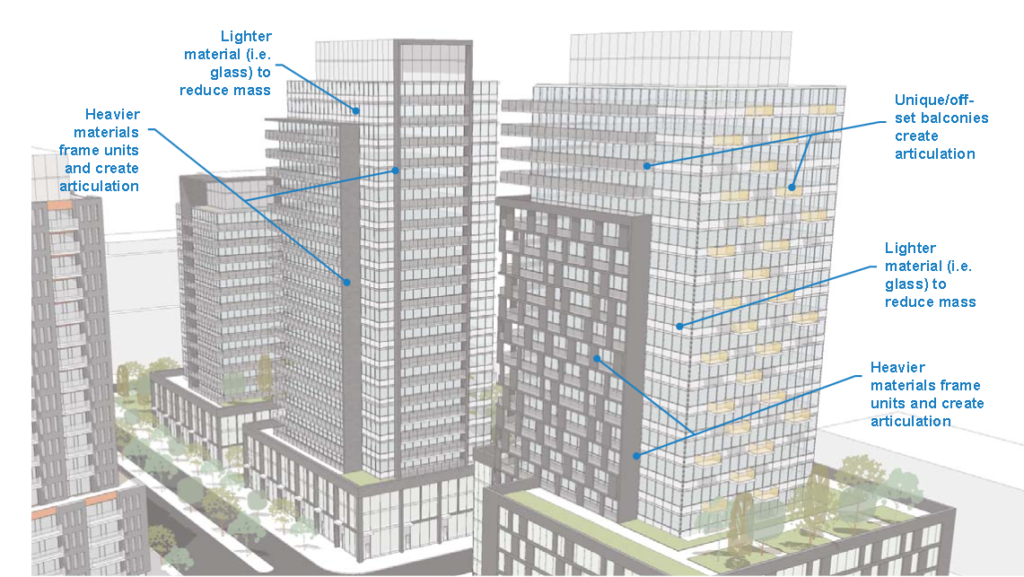
Just Guidelines – do they represent the city you want to live in? In order to have a specific number of metres space between two buildings – you have to have two buildings.
“Do we want a future which protects the livability, diversity and small town feel of our city, or something akin to Vancouver without the mountains?”
How did we get here?
“The guidelines were developed by outside consultants (BrookMcIlroy) at the request of city staff to deal with tall building applications already coming in.
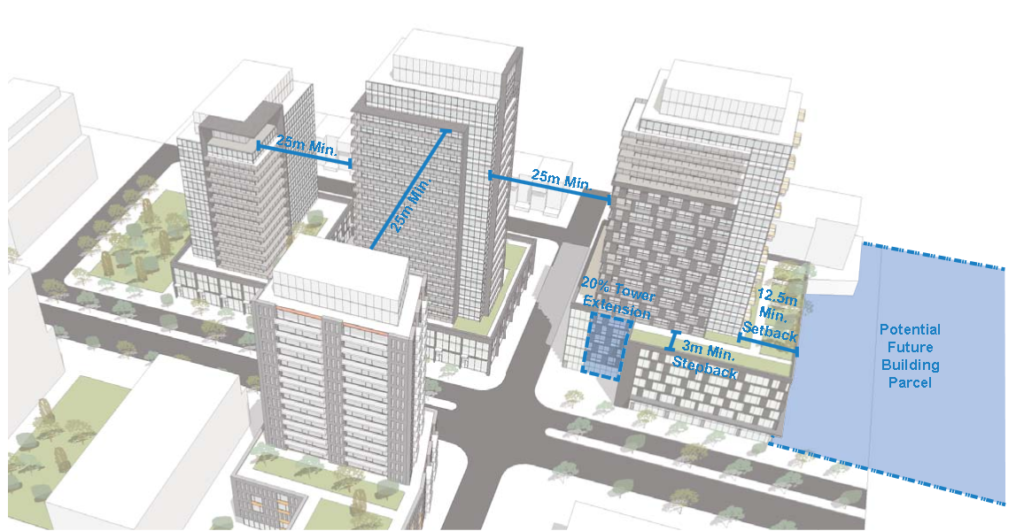 “They draw heavily on a style of planning called “Vancouverism” – narrow towers on podiums, setbacks to allow public activity on the street. Vancouver’s former city planner, Brent Toderian, is advising the city on planning, transportation and transit.”
“They draw heavily on a style of planning called “Vancouverism” – narrow towers on podiums, setbacks to allow public activity on the street. Vancouver’s former city planner, Brent Toderian, is advising the city on planning, transportation and transit.”
City council did pass the Guidelines and developers took to them with great gusto. The city’s Official Plan (OP) is in a sort of limbo while the planning department works at crafting a brand new OP. The old plan is still the rule but no one is doing all that much to support the document.
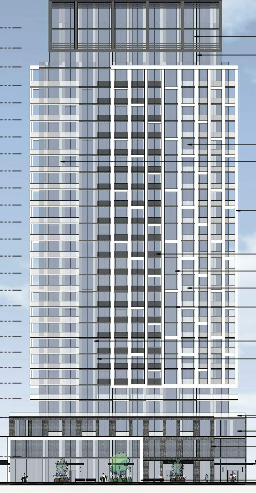
Less than six months after the Guidelines were approved a developer who had been assembling property on the east side of Brant street north side of James walks into city hall with an application that appears to conform with the Tall Building Guidelines.
Meed Ward points out that “Council had one week to review the guidelines. There was no prior public consultation. The development community was consulted before the report was prepared. Members of the city’s Housing & Development Liaison Committee received an electronic copy, with an invitation for tall building developers to attend one-on-one meetings with staff. But even developers said there wasn’t enough public consultation.
“Given the lack of public input, I had proposed the guidelines be considered “draft,” then sent out for community input. We need a “Made in Burlington” solution, not a model designed for a different city.”
However, the rest of council voted to put the Guidelines on the books.
The planning department committed to following up with the development community to hear their concerns.
The way the Tall Building Guidelines got put in place reminded Meed Ward of what was being done back in 2008 when planning changes to Old Lakeshore Road gave height along the waterfront without meaningful city-wide public input. That process created the Save Our Waterfront movement where 2,000 residents across the city sought better public consultation on changes like this, and eventually led to the creation of Burlington’s Community Engagement Charter.
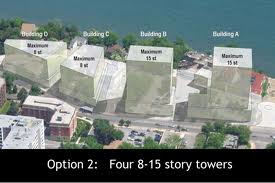
The fear back in 2010 was that tall buildings would get built along Old Lakeshore Road with heights in the eight to fifteen storey range – that didn’t go anywhere. What was proposed was 28 storeys (reduced later to 26) just a block away.
Save Our Waterfront also propelled Meed Ward into public office. She had previously run against Ward 1 Councillor Rick Craven and took a beating. She moved to ward 2, set up shop there as a persistent city council delegator and beat then ward Councillor Peter Thoem handily.
Meed Ward fears “We’re heading back to that era at council, where public input is bypassed, minimal or after the fact.”
All this led to a community meeting on Saturday that had about 60 people touring parts of the downtown core with comment from planners and a consultant on the look of specific buildings and what worked and what didn’t work all that well.
This after the Guide lines are already on the books and have been used by the ADI Development Group to justify their wish to put up two tall buildings (19 storey’s each) in Alton Village, a community with two story houses and townhouses where traffic congestion is horrendous.

The ADI Development Group project for the Alton Village was negotiated with the Planning department – but got killed at city Council after significant community opposition – it is no at the OMB appeal stage. It appears to meet the Tall Building Guidelines.
The Alton Village community organized and convinced council to not go with the Planning department recommendation – this after negotiating at considerable length with a developer that is not easy to negotiate with. It was a tough day for city planner Mary Lou Tanner – and it will be a tough OMB hearing which the developer has asked for on an expedited basis.
It will be tough on the taxpayer when the legal bills on this one come in.
Meed Ward points out that endorsing the guidelines now before we have finished our Official Plan and Zoning reviews may end up superceding our planning vision.
The risk she said is that the city will “get development applications that conform to the guidelines on setbacks or podiums, but are in places we don’t envision tall buildings. It will be very difficult to hold our ground and direct height to where we want it if the building meets our design guidelines, especially with the ever present threat of an appeal to the Ontario Municipal Board.
Tall buildings lead to more tall buildings; and sure enough along comes a development for 26 storey’s right across the street from city hall.
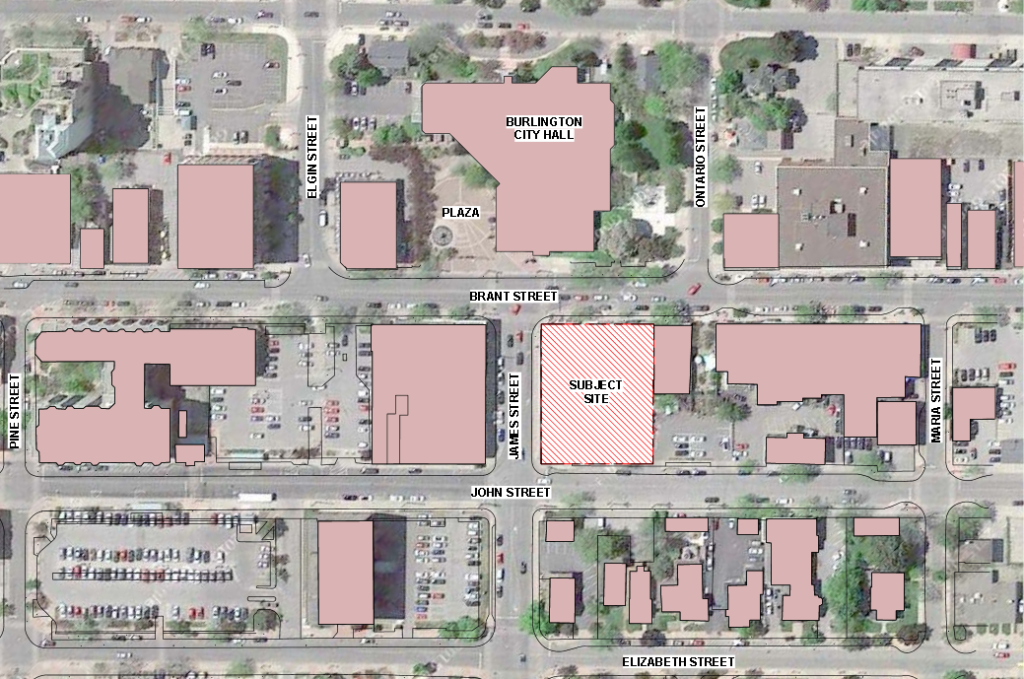
The space marked “subject site” is where a 26 storey tower that meets all the Tall Building Guidelines is proposed – right across the street from city hall.
The guidelines help pave the way, claims Meed Ward who adds that “pretty soon we will have lost meaningful control over planning and implementing a community vision for our city.”
Meed Ward wonders if “we’re headed toward intensification coupled now with a focus on tall buildings.
Is the city past the tipping point; is the die cast?
Making the Tall Building Guidelines part of the rule book.
26 storey tower across the street from city hall

















The COB is hiring a Land Economics Consultant, supposedly essential. You can read their justification for this request in the 2017 COB budget proposal (now rubber stamped). One can’t really argue with the case they make but only because COB have done such an appalling job to date.
So with reference to your article I had been wondering what Mayor Goldring meant when he said in his recent State of the City address (direct quote) “We are working with Brent Toderian and Jarrett Walker, who are leading thinkers on planning and transportation, to find a made-in-Burlington approach to transportation as we grow” this article is published.
I’m not sure what “working with” means – is that a euphemism for “we’ve hired these guys”?
The Mayor invited Brent Toderian to Burlington to speak February 11 2016 and again (“back by popular demand”, apparently) , together with Jarrett Walker on 14th November 2016; he’s obviously very impressed by Brent Toderian.
There is a lot of information about both of these gentlemen on the internet so your readers might be interested to Google them and find out about them for themselves. My own take on Brent Toderian is crystallized best in one of his own “talks” – the one I have chosen does, I believe, give a valuable insight into his mindset and is most appropriate because it was given here in Burlington. I make no other comment but invite anyone interested to cut and paste the link below and read it for themselves
https://bfastransit.ca/?p=516
As for Jarrett Walker, just read his blog – human transit.org – again, I make no comment but invite interested readers to form their own opinions.
You can also just search Brent Toderian and Jarrett Walker on City of Burlington website.
I think your readers may find some clues in some of this material as to where City of Burlington is going (and growing) and how they think they can get there. The Mayor really is “up for it”!
I don’t want to see a race for the sky by developers anywhere in Burlington. But, what bothers me the very most is – “who gets to decide height and density?”
Right now we have an existing OP that is being basically ignored, the Planning Director seems feckless to discourage such applications at the pre-proposal stage, and so we have a string of OMB hearings in waiting because the developers proposals are testing the waters.
I want to see the new OP brought forth with urgency so that the people of this city can weigh in, and be heard, to indicate what they want and what they will buy into.
They want and are legally entitled to have a say in my, “who gets to decide” question.
The tall building guidelines don’t mandate height, but are about spatial design criteria for heights above 15 stories, as I recall. They mean that you can’t stick any arbitrarily tall building just anywhere. It has to fit, and that means height too.
Given what has already been approved, and as a compromise, I can see 15 stories as something negotiable, with the Berkeley 17 stories as something already approved, acceptable to me in suitable blocks behind, but not right on Brant St.
Brant St. defines the Main street of downtown and needs exceptional protection so we can recognize it. That doesn’t mean nothing changes, but we have to be able to recognize our heritage in the low-rise street form.
I bumped into Oakville Mayor Burton a couple of months ago and asked him about the zoning on his downtown Lakeshore Rd. area. He told me that on that “Main” street, the height limit is 4 stories, but on either side of it, north and south, there is no limit.
He also told me that the North Oakville greenfield lands are pretty much all in the pipeline for development, but build-out is some time off. Remember, nothing of this happens quickly.
So it appears that he and Oakville Council want to protect the character of their “Main” street, and are directing height elsewhere, as I noted.
We all know that there is a tremendous financial incentive for developers to officially propose a push for more and more height because there are literally a billion dollars in the pot of 2000, $500,000 condos all around town, if you can get it. And that’s just for starters, and you can do other math.
So what we are seeing is what these dollars naturally lead to. The on staff or hired planners and lawyers already have more or less canned planning justifications and opinion, that can be tweaked and just moved around from place to place. Other hires fill in other needed reports that are always supportive.
Of course, it’s always justified by them, and called “good planning”. But it’s a nothing more than a narrative, leading to a foregone conclusion, and seeking a favorable decision. Lately, the opinions involve what “intensification” and “Places to Grow” mean.
Listen when I say that “good planning” is what the “planners” say it is. And no more than that. The developers buy these opinions in several forms. The stakes of the planning game make the relatively small cost of the proposal preparation worth the risk.
No matter what the city says, the OMB still acts as a placeholder for yet another narrative argument, seeking another “opinion”, by a likely single person Board Chair, but this one happens to be irrevocable.
Any extra cost for the OMB hearing is a cheap price for another final opinion compared to giving up if the city says no.
This happened recently in east Burlington, on a significant lakefront abutting property. The staff said no, city Council agreed, but the developer went off to the OMB on some drowning man straw argument about a past city decision about Lakefront lands.
Again, the stakes have been upped so high, by all these proposals for tall buildings, and higher density, that have an OMB backup for a second chance, that it has become seemingly irresistible.
This backdrop of the development reality that is unfolding is not going to change soon or until the province revises the OMB so this can’t happen. As we know, some changes are underway, but I don’t know if these proposals on the table now will be grandfathered under the old rules.
But aside from the OMB wild card, a development process that respects the wishes and consultation of the residents, as reflected in the present OP and zoning, is, as I said, not my primary concern. There are practical realities that are part of the normal planning operation.
My primary concern, again, is who gets to decide; who’s in charge?
Right now, to repeat, the present OP and zoning, reflecting residents opinions and buy-in, is being basically ignored by these proposals.
Instead, we see the OP being assaulted so that the developers, and unfortunately too many planners, can make it what they want it to be.
Certainly, in this environment I described, the residents are not in charge.
And worse, residents have not even been given the say and consultation process that they are legally entitled to in the formation of a new OP.
If we are going to have tall buildings, and much more density, then let the people have a say. That’s what I see as missing, and want.
To me, the planners seem to be sliding into that urban form with no public consultation on the locations, and the specifics of proposed heights and densities, that they have in mind.
This must stop. Something has got to be done about this before what decides is anarchy.
John:
“We won’t see the tax benefits until these projects are complete and on the city’s roll however, consider the property tax from just the Paradigm project could have reduced this years increase to about 3%.” This is very interesting, very insightful. How do you calculate this? Where does this information come from?
Mike, looks like John isn’t going to answer your question how he gets his info. Maybe he does have someone inside (staff and/or council) feeding him this stuff and maybe pulling his strings. Just sayin’.
C Jester
If I had known my delayed response was going to cause your speculation and paranoia regarding staff, council and myself, I certainly would have explained earlier.
Understanding how any property effect’s tax increases is a very simple calculation. You need to know three things, city’s tax levy, type and assessed value of a property and the tax rate, all available from the city on line.
In the case of new developments, a best guess of value can be determined simply by evaluating the prices, again available on line.
Nothing to worry about, it’s just simple math.
Yeah, right.
We lived in downtown Toronto for most of our working life and for years dreamt of the time we could retire to a place away from the noise and the traffic. We chose Burlington and it was a dream come true. Now, years later, we are being surrounded by high rise buildings, traffic congestion on the roads and the peaceful, serene feeling we had is disappearing fast. Even friends who used to come for the festivals are staying away because, as they say, it is too difficult to drive round due to all the traffic, parking is a problem and “it just isn’t the same”. Burlington is becoming a high rise residential nightmare. Most of the people moving into these condos work outside of Burlington and spent their free time outside of Burlington. The only reason they buy here is because it is cheaper than living in the GTA.
Could people stop writing “No where to grow but up” as if their is some reason that Burlington has to grow as fast as possible no matter the consequences. We are above places to grow targets. Thus we should only grow if that growth brings and advantage to current and future residents.
Everyone in the world doesn’t want to live in Manhattan and you should not try and turn everyplace into it – even if you could.
Totally agree! I live downtown and the last thing I want to see is Burlington become like Toronto – a depressing mass of skyscrapers that block the view of the lake, create wind tunnels and take away the character of the City.
“Is the city past the tipping point; is the die cast?”
Three tall building development’s under construction, Berkeley 17 storeys, Bridgewater 22 storeys and the Paradigm 18-24 storeys.
This council approved the height of one, the Berkeley, prior to any mention of tall building guidelines.
Three tall building proposal’s, Alton 2 x 19 storeys, Nautique 26 storeys and the latest 26 storeys on Brant.
Two proposals were submitted prior to tall building guidelines and rejected unanimously by council. The third and newest has yet to be discussed but, appears to adopt some of tall building guidelines.
With that many and likely more proposals in our future tall building guidelines are overdue.
Controlling height and location are very different matters.
We won’t see the tax benefits until these projects are complete and on the city’s roll however, consider the property tax from just the Paradigm project could have reduced this years increase to about 3%.
The City of Burlington has already lost control of planning! There is no vision and some cowboy developers now run the City.
How is it Oakville has virtually no high-rise buildings in their downtown, yet we are being mandated to grow by the Government, taken advantage of by many developers, and ignored by the OMB?
Meanwhile the School Board wants to close Central High! A complete farce.
Oakville has North Oakville, the area between Dundas Street and Highway 407. That is a huge land area that accounts for most of Oakville’s growth. They still have greenfields, whereas Burlington does not. That’s the difference. Once those lands are all developed they’ll be in the exact same position as Burlington. Nowhere to grow but up.
Meed Ward fears “We’re heading back to that era at council, where public input is bypassed, minimal or after the fact.”
I hate to tell you this Marianne but I don’t think there has ever been a time when this Council really listened to public input….which is why most of them, and particularly our Mayor, will be given their pink slips come October 2018! After that we can focus on cleaning out the mandarins at City Hall.
“We’re heading back to that era at council, where public input is bypassed, minimal or after the fact.”
I’m beginning to think it’s a little worse than that. I think the city as a unit knows that no one wants to live in the place they are proposing. Most of the effort is in trying to hide the impact of this or figure out how to force people to live in such a place.
Option 3 – Let’s vote out anyone in support of this insane unmanaged overbuilding.
I’m fine with intensification so long as it has a transportation plan, parks plan and tax plan that is not just a one way burden to existing residents.
While highrise buildings are inevitable for Burlington, I must warn that a Vancouver model is hardly acceptable. Have any of the members of council ever stayed in Vancouver’s West End for any length of time. They’ll soon discover that what was once a beautiful part of Vancouver is a mess in every way imaginable. This is not a solution for us. I grew up in the West End, and whenever I have revisited the place, I am horrified to hear about the woes of what it is like to live there now. The made-in-Vancouver solution does not take into consideration the difference in climate. All these glass towers will be hard to keep warm. Toronto condo owners, who have moved into those glass structures along the downtown core, have discovered how bad it can be. So, public input is badly needed, and the city, by ignoring this democratic process seems to indicate that developers know how to dazzle the politicians, who are supposed to look after all of the citizens.
We have to grow up as we can’t grow out.
Since the City has basically built out of it’s urban boundary, there is only one solution for growth. Onwards and Upwards, nowhere to go but UP.